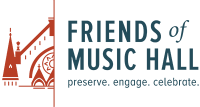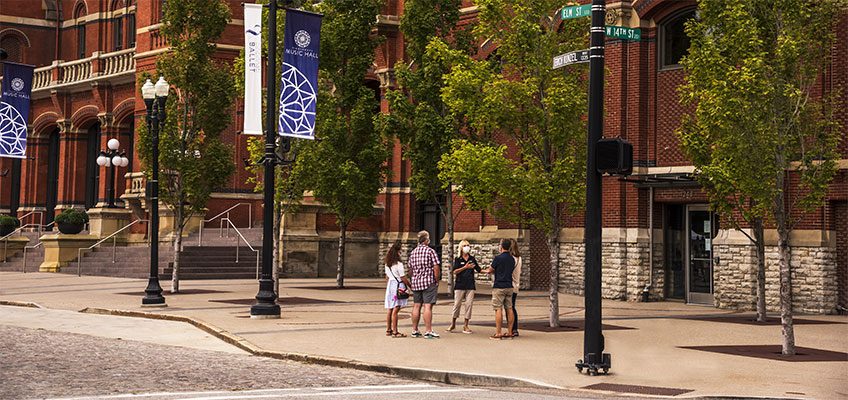Insights on Outdoor Building Tours of Music Hall from the Perspective of a Husband and Wife Team of Program Guides
By Barbara Gomes and Ron Hoffman
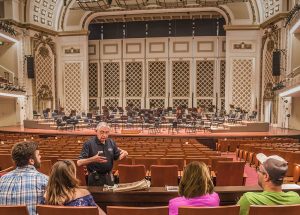
In 2016 we began giving inside tours of Cincinnati Music Hall as volunteers with the Friends of Music Hall. It was very satisfying to share the history of the Hall as well as its stunning architectural features.
Cincinnati Arts Association managed the Hall and did an amazing job of keeping the space as bright and sparkling as possible but there was obvious wear and tear especially backstage. We would point out some of these areas to our guests and then add that the Hall would be closing the end of May 2016 after the last May Festival performance and would not reopen to the public until the Cincinnati Symphony Orchestra season began early in October 2017. During this period over $145M was spent on renovation and restoration both inside and outside of Music Hall.
Volunteer Tour Guides Stayed Busy During the Revitalization
So what would the Friends of Music Hall volunteers do during this closure? How could we assist with keeping Music Hall in the public eye? The answer was to develop outdoor building tours where we could incorporate some of the history of Music Hall, as well as talk about the different architectural details of the exterior. Finally we could also touch on the history and architecture of some of the homes and buildings in the surrounding area.
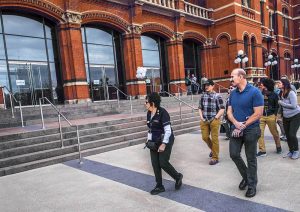
Making Downtime Fruitful
What a learning experience this was for us! While Barbara studied history as an undergraduate, and had even spent time researching and studying Cincinnati’s history, she had a very superficial understanding of architecture. Both of us had only a passing understanding of how a building could tell its story.
As Barbara worked on developing the outdoor building tour with Thea Tjepkema (Board Member of the Friends of Music Hall and an historic preservationist), our pride and wonder about OUR Music Hall was reinforced. Meanwhile Ron provided behind-the-scenes editorial support since he has taught both English and literature at the college level.
Prepare to be Surprised!
When leading tours, we tell people about the “WOW’ factor. The “WOW” factor can be a very individual experience, but for us the building’s grandeur and multiplicity of detail always amaze us. Four years later, we are still mesmerized by the building, its history, its interesting architectural features, and the many stories that echo through the halls, the rooms, the very bricks of this venerable building.
Let us share a few of these moments with you and hope that this will encourage you to take one of our outdoor building tours which Friends of Music Hall has recently resumed, following enhanced safety procedures due to the covid-19 pandemic.
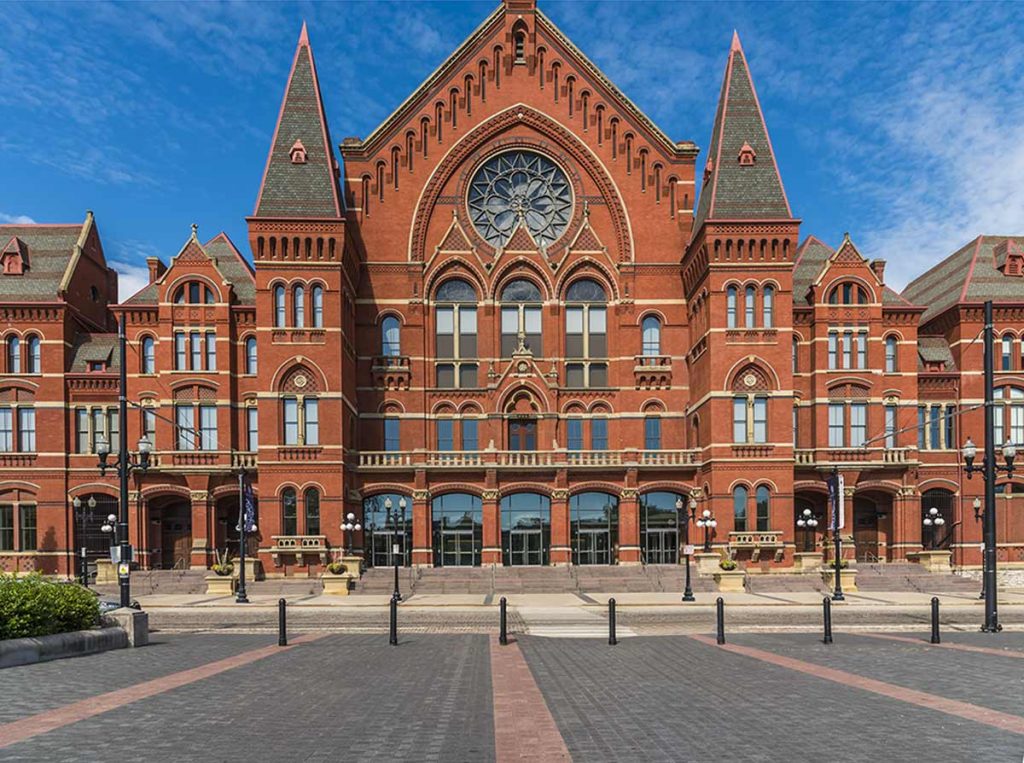
Grandeur
Standing in Washington Park and facing Music Hall, we are really viewing three separate buildings. The center building accommodated music events, while the north wing was called Mechanics Hall and the south wing was the Horticulture or Arts Hall.
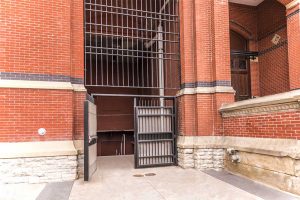
The division between the buildings is easily identified by two iron gates which show where the carriage passageways were located. It delineated the spaces between the buildings and was used during the early years to transport wealthy patrons from Elm Street (East Façade) through the building to what is now Central Parkway (the West Façade). Imagine attending a May Festival Concert in the late 1800s. Dozens and dozens of horse drawn carriages arrive at the Hall, drive to the center of the passageway and drop the guests off at a side entrance. It must have been quite a spectacle to those observing this event from Elm Street.
When Music Hall was completed in 1879, it was considered to be one of the best examples of High Victorian Gothic architecture. Viewed from Washington Park, we can show our guests many of the building’s typical Gothic features such as the Rose Window and pointed arches. But the real fun begins when we get up close in order to view details that were part of Samuel Hannaford’s architectural vision.
Details: Where to Find Them, What They Mean
We also like to highlight our bricks. We point out that two kinds of bricks were used in constructing the exterior of the building: pressed decorative red bricks for the East Façade (from Philadelphia, Pennsylvania and Zanesville, Ohio) and local Ohio orange bricks for the sides and back (West Façade). The city wanted to have their best bricks in the more visible front of the building, just as many homes of this period contained the “best” furniture in living rooms and dining rooms in order to impress visiting guests!

We also enjoy showing off glimpses of the original mortar that Hannaford, the architect of Music Hall, proposed: black for the dark red bricks on the East Façade and yellow for the yellow/orange bricks on the side and West Facade. During the renovation of the 1970s the brick was sandblasted, and the original mortar was covered over. But there are still places where the original mortar peeks through. Before the outdoor building tour season begins each year we enjoy revisiting the vestiges of the original mortar, for they are an important part of Music Hall’s history.
Beautiful Stone Carvings
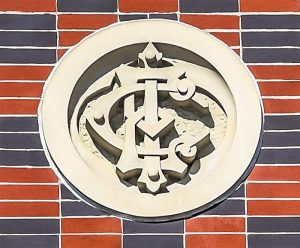
Sandstone carvings on both the East and West Facades also tell a story. These medallions remind us of our visits to European medieval cities. Merchants had to find a way to describe their services to their mostly illiterate customers. The custom was to hang a sign representing their trade: a tankard for a tavern, a horseshoe for a blacksmith, a pair of scissors for a tailor and so on. The Music Hall carvings served the same purpose. They tell the story of the many different activities that took place in the Hall from its very beginning. In the central building there are carvings of lyres among a variety of other instruments representing orchestral music. In addition, there are carvings of birds with open beaks representing choral music.
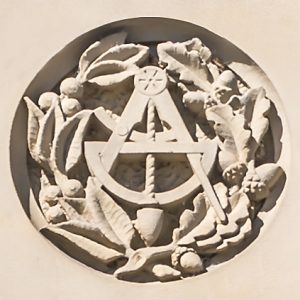
On the North Hall there are gears and a sextant representing the machines that were displayed at Expositions held here when it was called Mechanics Hall. Also over the doors of both the North and South Halls there is a sandstone medallion with the initial CIE, which stands for Cincinnati Industrial Expositions. (You can read more at Expositions in Cincinnati and Music Hall).
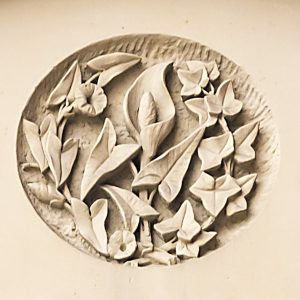
On the South Hall there are carvings of various flowers representing the horticultural displays that were once displayed here. Barbara’s personal favorite is a Calla Lilly. We have to look carefully for the Calla Lilly because there is only one on the entire building. Because of these carvings and what they symbolize, we gain a better understanding of how Music Hall started its life as a multi-purpose complex and, indeed remains so to this day.
There is so much else to see when we walk around this building: the fossils in the limestone foundation, the magnificent Rose Window, the arches, the interesting designs made with black bricks that have recently been restored, and the magnificent oak doors with their iron hinges. And one of the best ways to accomplish this is to join an outdoor building tour provided by the Friends of Music Hall. The knowledgeable tour guides will present an hour of entertainment, history, and aesthetic appreciation of Music Hall and of the surrounding neighborhood. We look forward to seeing you on an outdoor building tour in the near future.
